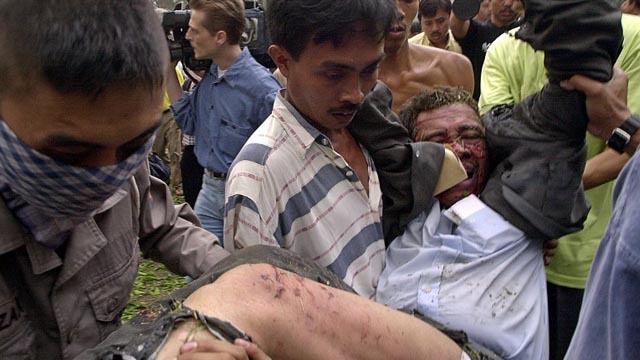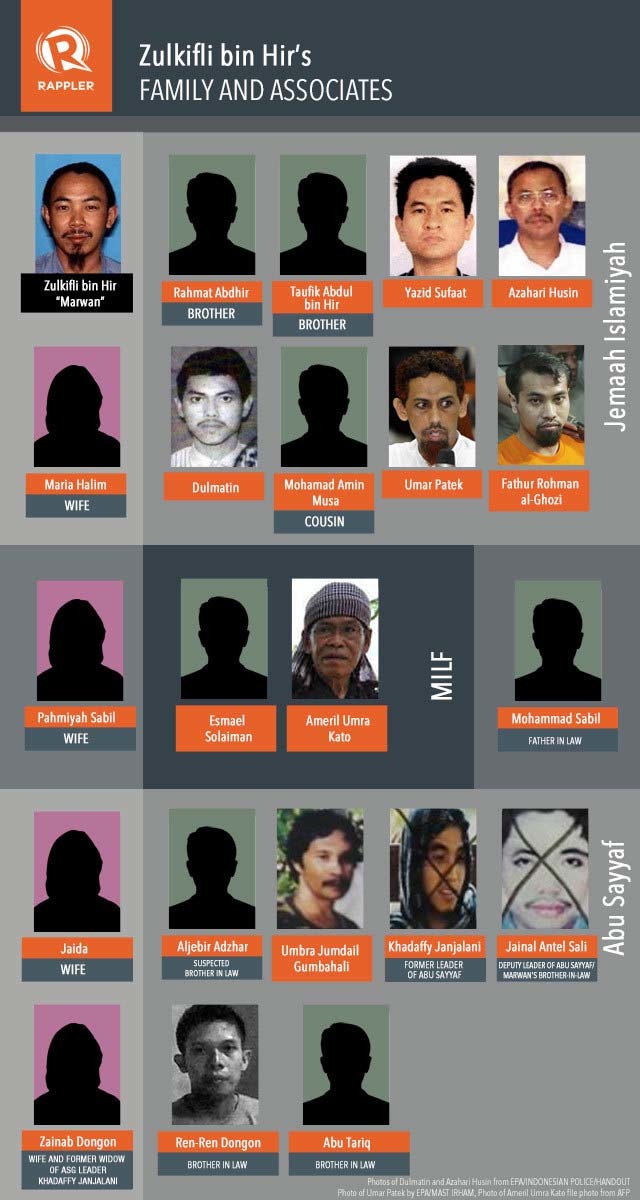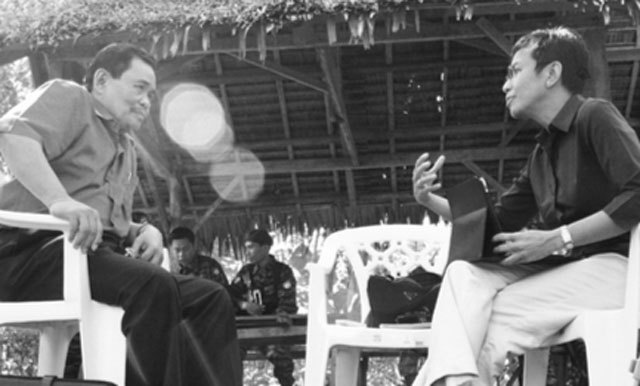In 2002, authorities around the world did not know the role of Marwan in terror networks. Looking back, we can piece together the ties that bind him and his family to local and global terror plots.

Conclusion
Part 1: EXCLUSIVE: Marwan's ties that bind: Aljebir Adzhar aka Embel
Part 2: EXCLUSIVE: Marwan's ties that bind: Ren-Ren Dongon
The movements of Fathur Rohman al-Ghozi was being tracked by many intelligence services around the world: the Americans thought he was a low-level al-Qaeda operative; the Singaporeans labeled him a high-level Jemaah Islamiyah leader; and the Filipinos claimed he was MILF, one of the first times the Moro Islamic Liberation Front would be publicly linked to terrorism.
Al-Ghozi was key to about 30 near-simultaneous bombings of churches across Indonesia and 5 near-simultaneous explosions in the Philippines, the worst killing 22 people in a Manila commuter train (now known as the Rizal Day bombings in December 2000). He also created and set off a bomb outside the Philippine ambassador’s house in Jakarta, Indonesia, 4 months earlier.

After Al-Ghozi was arrested in January 2002, he told the Philippine police about his hideout in General Santos City. When they raided it, they found 1.2 tons of explosives slated for al-Qaeda’s ambitious suicide truck-bombing plots in Singapore targeting Western embassies and interests. It was supposed to be carried out by JI members working with al-Qaeda suicide bombers and needed 21 tons of explosives.
In 2002, authorities around the world working to prevent ongoing plots didn’t know the role Marwan played in these networks. Now, looking back, we can piece together the ties that bind him and his family to local and global terror plots. In that hideout, along with the explosives, the Philippine police found an identity card with the picture of Marwan, a Malaysian terrorist whose real name is Zulkifli bin Hir. It was the first time authorities in the Philippines would see the man whose death in a special forces operation 13 years later would cost the lives of 44 police special operatives.
The information comes from interviews and classified documents obtained over more than a decade of research from nearly half a dozen nations and verified by at least two independent sources.
US-educated
From al-Ghozi’s hideout, Philippine police filed away that Indonesian identity card of Hendri Lawi from Makassar, Indonesia. This is the first time it's being released publicly. The card had a picture of a half-smiling Marwan looking like a businessman in his suit.

Marwan’s brother, Rahmat Abdhir, arrested in the United States in 2007, told the FBI a year later that Filipinos who trained with Marwan in Afghanistan helped him flee to the Philippines in 2001 to escape arrest in Malaysia. Marwan was wanted by Malaysian authorities for his role in the assassination of a lawmaker and a bank robbery carried out by a group he led, the Kumpulan Mujahideen Malaysia, an affiliate group under the umbrella of Jemaah Islamiyah. JI itself was seen then as al-Qaeda’s arm in Southeast Asia.
At the time, Marwan was training members of the MILF and working closely with al-Ghozi to source the 21 tons of ammonium nitrate needed for their plots, not just in the Philippines, but also in Malaysia.
Rahmat said Marwan was working with Yazid Sufaat, a Malaysian who experimented with biological weapons for al-Qaeda and who hosted some of the 9/11 hijackers in his apartment in Kuala Lumpur, Malaysia’s capital. Sufaat used a company he owned to purchase 4 tons of ammonium nitrate, which Marwan arranged to hide in a palm oil plantation near Muar, Malaysia.
Marwan's wives
That plantation was owned by Marwan’s uncle. When the 4 tons of ammonium nitrate was discovered, Marwan's cousin, Mohamad Amin Musa, was jailed by Malaysian authorities.
Marwan comes from a family of jihadists: in 2001, his youngest brother was arrested for the Atrium bombing plot in Indonesia; in 2003, his cousin, whom authorities suspected of recruiting young Malaysians for training in the Philippines, was arrested in Malaysia; and, in 2007, his brother, Rahmat, was arrested in the United States.
Here’s another example of the ties that bind: Rahmat’s roommate in San Jose, California, is the brother of Marwan’s first Malaysian wife, Maria Halim. She and Marwan have at least one daughter.
Rahmat was arrested by US authorities for funneling money and resources to Marwan in the Philippines. Rahmat transferred money to the Philippines by using the bank accounts of Marwan’s second wife, Filipina Pahmiyah Sabil. She married Marwan sometime in the 3rd quarter of 2003, and as of 2006, they had a daughter and a son. Part of the money transferred by Rahmat came from the brother of Marwan’s first wife.
Pahmiyah is the daughter of Mohammad Sabil, the barangay chairman of Talitay, Pikit, North Cotabato. Their extended family includes members of the MILF. The family had enough local and political clout that when Marwan repeatedly got sick with acute kidney disorder and hypertension in 2006, they were able to get him a doctor who treated him at an MILF camp, and when that didn’t work, they rented a boat and an L-300 van to bring him for treatment to a health center, where Pahmiyah’s cousin worked.
Marwan liked the Philippines and Filipino women, marrying at least two more in succeeding years. At one point, Pahmiyah complained and confronted Marwan, who “is fond of looking for a text mate on his cellular phone, particularly women.”
From 2003 to 2006, Marwan moved at least 8 times, moving around Cotabato City, Maguindanao, and North Cotabato. In 2005, he and Pahmiyah lived in Mamasapano, where he would eventually be killed by special police operatives in January 2015.

MILF links
Through most of his time in the Philippines, Marwan found shelter with armed groups: the MILF in central Mindanao, and the Abu Sayyaf in Jolo, where he lived from 2010 to 2012.
In the early years, it seemed part of the reason he was in Pikit was to be near the MILF leadership. In 2005, when the central leadership kicked out the Abu Sayyaf, Rajah Solaiman Movement, and Jemaah Islamiyah, Marwan moved into a house in Kabuntulan, Maguindanao.
In March 2006, Marwan and his family moved into the operational base of then MILF commander Esmael Solaiman, also known as Abu Hashim, in Pikit, North Cotabato. Abu Hashim is an Afghan-trained confidant of former MILF chairman Hashim Salamat. Marwan was also welcomed at different times in the 105th and the 108th base command of the MILF. In exchange, Marwan would train MILF members.

“Our situation is similar to the United States in Afghanistan,” MILF chief negotiator Mohagher Iqbal told me in 2011. “The Americans and Osama bin Laden, they were friends. They were siding with each other when the Russians were invading Afghanistan. They were even sharing the same troops, see? In other words, sometimes you cannot choose your friends.”
For years, the MILF kept the JI card, its special operations group, and links to the Abu Sayyaf as options – but far enough away for plausible deniability. Iqbal hinted that revolutionary groups and guerrilla armies around the world use tactics like this to level the playing field against larger and better-armed forces of government. The problem, of course, is that it tainted the MILF’s own revolutionary cause.
So the MILF central leadership evolved: from turning a blind eye early on, to kicking out terrorists who might endanger the peace talks in 2005, to taking disciplinary action against leaders like Ameril Umra Kato – head of the 105th base command – for “coddling JI leaders” in 2008.
It’s interesting that when JI leaders brokered the Abu Sayyaf’s move from Basilan and Jolo to MILF camps in central Mindanao in 2003, they talked to Kato. In 2011, Kato and his men broke away from the MILF and formed the Bangsamoro Islamic Freedom Fighters or the BIFF.
Kato and his men continued to shelter Marwan until the end.
[Maria A. Ressa is the author of Seeds of Terror: An Eyewitness Account of Al-Qaeda's Newest Center of Operations in Southeast Asia and 10 Days, 10 Years: From Bin Laden to Facebook.]

No comments:
Post a Comment
Note: Only a member of this blog may post a comment.